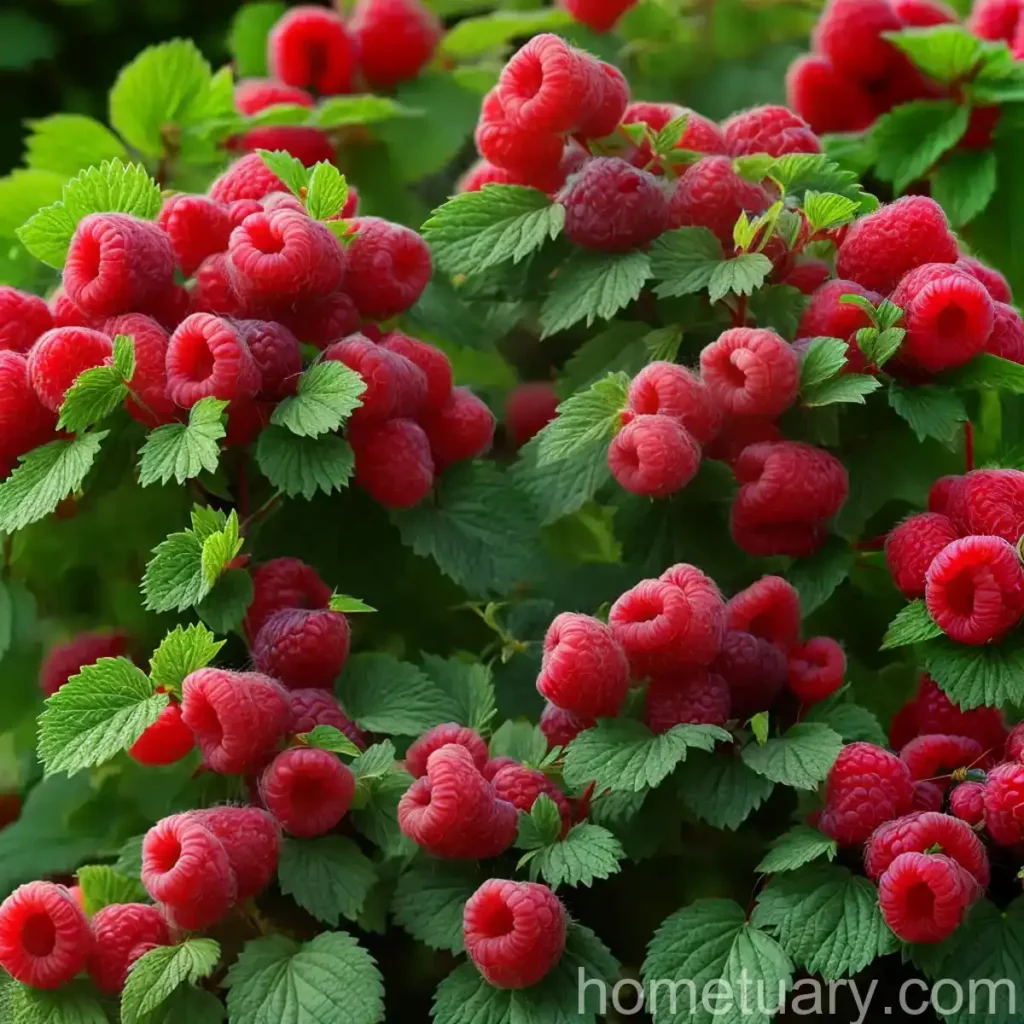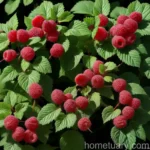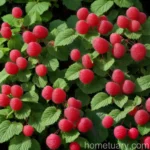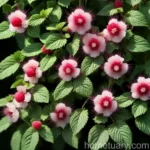Red Raspberry (Rubus idaeus ‘NR7’ BUSHEL AND BERRY RASPBERRY SHORTCAKE)
Red raspberry, scientifically known as Rubus idaeus ‘NR7’ BUSHEL AND BERRY RASPBERRY SHORTCAKE, is a delightful dwarf raspberry plant. It is a compact, self-pollinating, and everbearing shrub that produces delicious edible berries. This variety is an excellent option for those with limited garden space, as it can thrive in containers, making it a perfect addition to small gardens, patios, or balconies. In this comprehensive guide, we will delve into the culture, uses, cultivation requirements, common diseases, pests, and botanist’s tips for growing and caring for this delightful red raspberry variety.
What is Red Raspberry (Rubus idaeus ‘NR7’ BUSHEL AND BERRY RASPBERRY SHORTCAKE)?
Red raspberry, Rubus idaeus ‘NR7’ BUSHEL AND BERRY RASPBERRY SHORTCAKE, is a popular fruit-bearing perennial plant known for its compact size and delectable berries. This raspberry cultivar has been specifically bred to thrive in small spaces and containers, catering to urban and small garden environments. With its charming appearance and bountiful harvest, the Red Raspberry Shortcake plant is a versatile addition to any garden, offering both ornamental value and a delicious edible yield.
Key Takeaways – Red Raspberry (Rubus idaeus ‘NR7’ BUSHEL AND BERRY RASPBERRY SHORTCAKE)
Before diving into the intricacies of the red raspberry plant, let’s summarize the key features of the Rubus idaeus ‘NR7’ BUSHEL AND BERRY RASPBERRY SHORTCAKE variety.
- Plant Type: Fruit-bearing shrub
- Variety: Red Raspberry (Rubus idaeus ‘NR7’ BUSHEL AND BERRY RASPBERRY SHORTCAKE)
- Characteristics: Dwarf, compact, and self-pollinating
- Use: Edible berry production
- Adaptability: Suitable for containers and small-space gardens
Now, let’s explore the essential aspects of cultivating and caring for the Red Raspberry Shortcake plant to ensure a successful and rewarding growing experience.
Culture
Uses
The Red Raspberry (Rubus idaeus ‘NR7’ BUSHEL AND BERRY RASPBERRY SHORTCAKE) showcases a myriad of uses, encompassing both functional and aesthetic purposes.
- Edible Berries: One of the primary uses of this raspberry variety is its production of delectable, red berries. These berries are not only flavorful but also packed with nutritional benefits, making them a valuable addition to the home garden.
- Ornamental Value: Beyond its fruit-bearing capabilities, the Red Raspberry Shortcake plant also adds ornamental value to the garden with its lush foliage and charming appearance, making it an appealing choice for landscaping.
Water
Proper watering is essential for the healthy growth and abundant fruiting of the Red Raspberry Shortcake plant. It is crucial to maintain consistent moisture levels in the soil, especially during the growing season and fruit development. However, it is equally important to avoid waterlogging, as excessive moisture can lead to root rot and other detrimental conditions.
Sunlight
The Red Raspberry (Rubus idaeus ‘NR7’ BUSHEL AND BERRY RASPBERRY SHORTCAKE) thrives in full sun to partial shade, making it adaptable to various light conditions. However, to maximize fruit production and overall plant vigor, it is best to position the plant in a location that receives at least 6-8 hours of direct sunlight daily.
Fertilizer
Proper nutrition is crucial for the Red Raspberry Shortcake plant to flourish and yield abundant, high-quality berries. A balanced fertilizer formulated for fruit-bearing plants can be applied in early spring as new growth emerges. Additionally, organic mulch can be used to enrich the soil and promote optimal growing conditions for the raspberry bush.
Soil
The Red Raspberry (Rubus idaeus ‘NR7’ BUSHEL AND BERRY RASPBERRY SHORTCAKE) thrives in well-draining, fertile soil with a slightly acidic to neutral pH range. A loamy, rich soil type is ideal for promoting healthy root development and overall plant vitality. Prior to planting, it is recommended to amend the soil with organic matter to enhance its nutrient content and structure.
Pruning
Proper pruning plays a pivotal role in the cultivation of the Red Raspberry Shortcake plant. Regular pruning helps maintain the plant’s compact form, promotes air circulation, and facilitates optimal fruit production. The following guidelines are beneficial for pruning the raspberry bush:
- Annual Pruning: Prune the plant in late winter to early spring before new growth emerges.
- Remove Dead Canes: Eliminate any dead, damaged, or diseased canes to prevent the spread of pathogens.
- Thinning: Thin out the canes to enhance airflow and sunlight penetration, which contributes to the overall health of the plant.
Propagation
The Red Raspberry (Rubus idaeus ‘NR7’ BUSHEL AND BERRY RASPBERRY SHORTCAKE) can be propagated through various methods, including division, tip layering, and stem cuttings. Propagation allows for the expansion of raspberry plants and the preservation of desirable traits. Here are the primary methods of propagating the Red Raspberry Shortcake plant:
- Division: Divide established raspberry plants by carefully separating the root mass into individual sections, each containing viable roots and shoots.
- Tip Layering: Encourage the formation of new roots by burying a portion of a raspberry plant’s shoot while it is still attached to the parent plant. Once roots develop, the new plant can be separated and transplanted.
- Stem Cuttings: Select healthy, disease-free stems and cut them into sections to be used for propagating new raspberry plants. These cuttings can be rooted in a suitable growing medium and transplanted once they have established strong root systems.
Container Popularity
The Red Raspberry (Rubus idaeus ‘NR7’ BUSHEL AND BERRY RASPBERRY SHORTCAKE) has garnered widespread popularity as a container plant, particularly among gardeners with limited space and urban garden enthusiasts. Its compact size, adaptability to container gardening, and ornamental and fruit-bearing qualities have made it a sought-after addition to patio gardens, balconies, and small-space landscapes.
Container Common Diseases
While container gardening offers numerous advantages, it is essential to be mindful of potential diseases and issues that may arise in this growing environment. Some common diseases that may affect red raspberries grown in containers include:
- Powdery Mildew: A fungal disease that presents as a white, powdery coating on the leaves and stems.
- Anthracnose: Another fungal disease that causes dark, sunken lesions on the fruit and can lead to plant decline if left untreated.
- Root Rot: Excessive moisture in container soil can result in root rot, negatively impacting the overall health of the plant.
Proactive measures, such as proper watering practices, adequate air circulation, and regular monitoring for signs of disease, can help mitigate these issues and promote the well-being of container-grown red raspberries.
Disease Diagnosis
Diagnosing diseases in red raspberry plants is crucial for implementing timely and effective management strategies. When identifying potential diseases, it is essential to consider the following factors:
- Symptoms: Recognizing the visual symptoms displayed by the plant, such as leaf discoloration, spots, or unusual growth patterns.
- Environmental Conditions: Assessing the prevailing environmental factors, including temperature, humidity, and sunlight exposure, which can influence disease development.
- Cultural Practices: Reviewing the plant’s care regimen, including watering, fertilization, and pruning, to identify any potential stressors or contributing factors to disease susceptibility.
Seeking guidance from local agricultural extension services or certified plant pathologists can aid in accurate disease diagnosis and the implementation of tailored management strategies.
Common Pests
While the Red Raspberry (Rubus idaeus ‘NR7’ BUSHEL AND BERRY RASPBERRY SHORTCAKE) is relatively resistant to pests, it may still encounter occasional infestations. Common pests that can affect red raspberry plants include:
- Japanese Beetles: These voracious feeders can defoliate raspberry plants if left unchecked.
- Spider Mites: These tiny pests suck sap from plant leaves, leading to stippling and reduced photosynthetic capacity.
- Raspberry Fruitworm: The larvae of this pest can cause damage to raspberry fruit, leading to reduced yields and compromised quality.
Vigilant monitoring and prompt intervention are vital for managing pest pressures in red raspberry plants to prevent significant damage and yield loss.
Botanist’s Tips
Here are some expert tips from botanists and experienced growers for cultivating and caring for the Red Raspberry (Rubus idaeus ‘NR7’ BUSHEL AND BERRY RASPBERRY SHORTCAKE):
- Proper Drainage: Ensure that the containers for red raspberries have adequate drainage to prevent waterlogging and root rot.
- Regular Feeding: Incorporate a balanced, slow-release fertilizer specifically formulated for fruit-bearing plants to provide essential nutrients throughout the growing season.
- Mulching: Apply a layer of organic mulch around the base of the raspberry plant to conserve moisture, suppress weeds, and enrich the soil.
- Wind Protection: Shield container-grown raspberry plants from strong winds, as excessive wind exposure can stress the plant and hinder fruit development.
- Seasonal Care: Adjust care practices based on seasonal changes, such as increased watering in hot weather and winter protection in colder climates.
Fun Facts
To add an element of fascination to the cultivation of Red Raspberry (Rubus idaeus ‘NR7’ BUSHEL AND BERRY RASPBERRY SHORTCAKE), here are some engaging fun facts about this delightful fruiting plant:
- The red raspberry is a member of the rose family, Rosaceae, and is closely related to other beloved fruits, including strawberries and blackberries.
- Raspberry leaves have been used in traditional herbal medicine for their potential health benefits, such as promoting digestive wellness.
- Red raspberries are rich in antioxidants, vitamins, and dietary fiber, making them a nutritious and flavorful addition to a balanced diet.
- The Rubus idaeus ‘NR7’ BUSHEL AND BERRY RASPBERRY SHORTCAKE variety is prized for its compact growth habit, making it an excellent choice for small-space gardens and container cultivation.
Links to External Resources
To further expand your knowledge and resources on red raspberry cultivation, here are some valuable external links:
- Growing Raspberries in Your Home Garden
- Raspberry Planting and Care Guide
- Managing Diseases in the Home Fruit Planting
The provided external resources offer comprehensive information on raspberry cultivation, disease management, and best practices for optimal plant care.
In conclusion, the Red Raspberry (Rubus idaeus ‘NR7’ BUSHEL AND BERRY RASPBERRY SHORTCAKE) stands as an exceptional choice for gardeners seeking a compact, fruit-bearing perennial that thrives in small-space environments. By adhering to the outlined cultural practices, effective disease management strategies, and expert tips, you can nurture thriving red raspberry plants and enjoy a bountiful supply of delectable berries year after year.
References:
– University of Minnesota Extension. “Growing Raspberries in Your Home Garden.” Extension. https://extension.umn.edu/fruit/growing-raspberries-home-garden
– Royal Horticultural Society. “Raspberry Planting and Care Guide.” RHS. https://www.rhs.org.uk/advice/grow-your-own/fruit/raspberries
– University of Minnesota Extension. “Managing Diseases in the Home Fruit Planting.” Extension. https://extension.umn.edu/planting-and-growing-guides/managing-diseases-home-fruit-plantings















